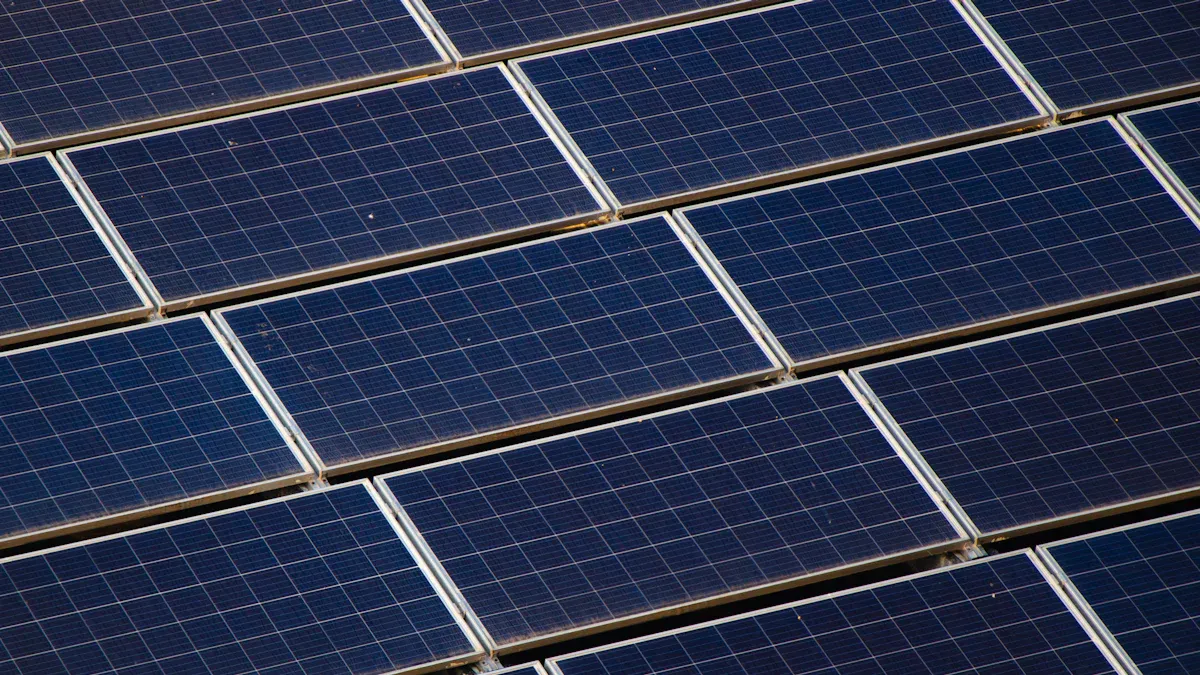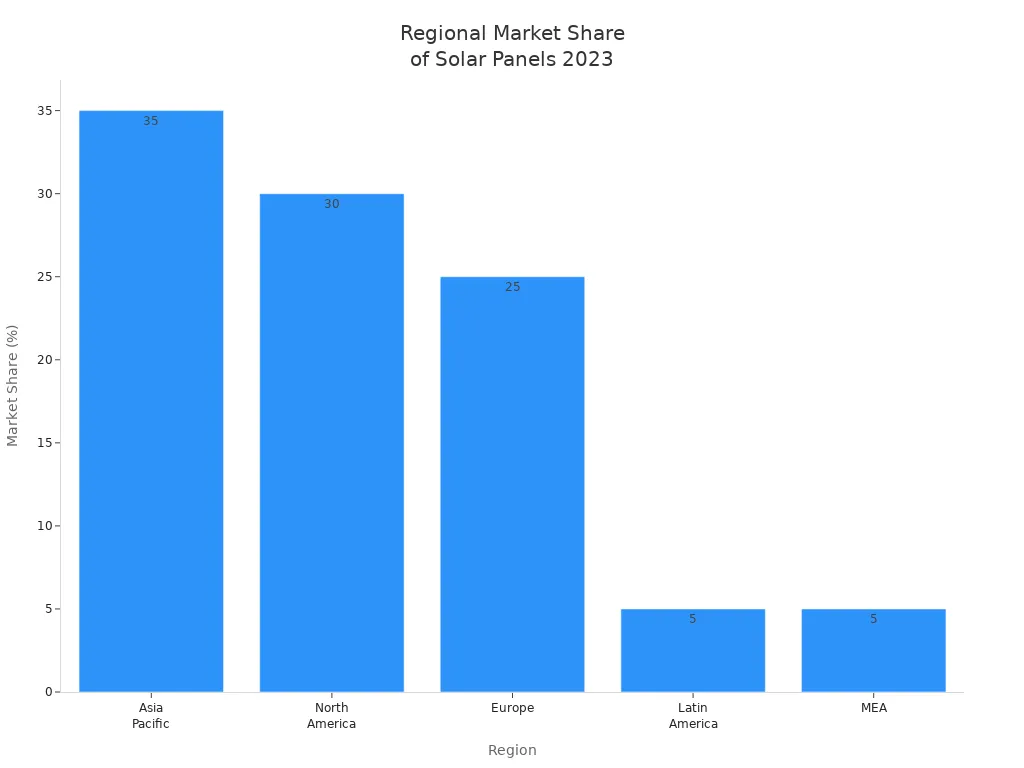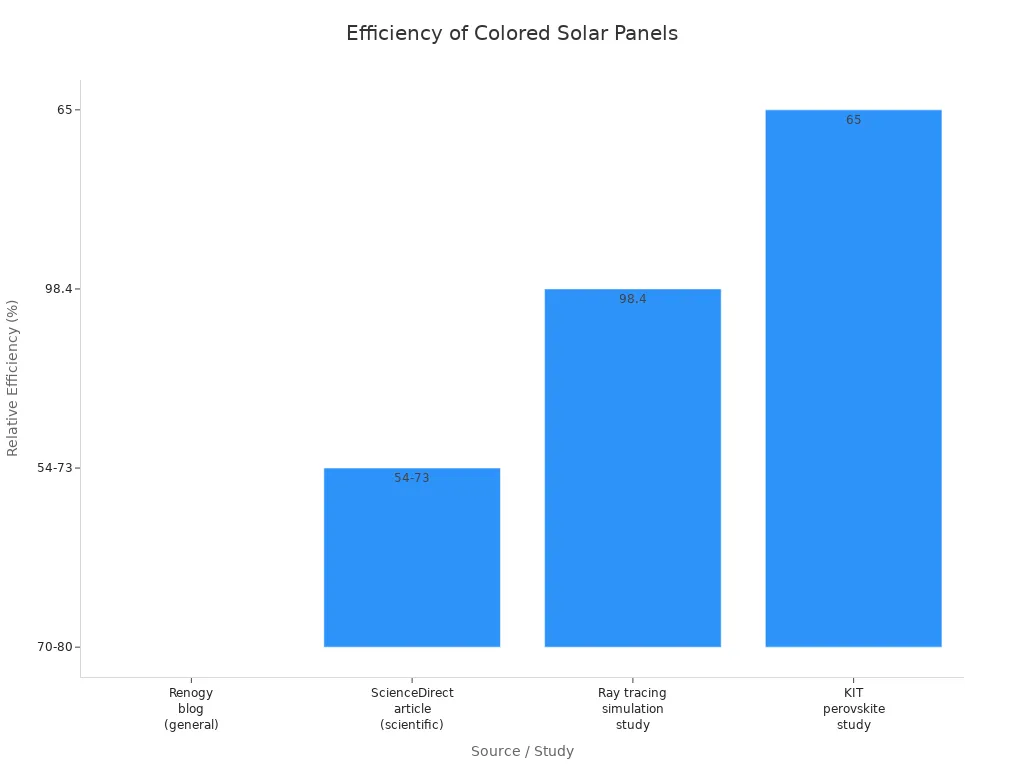+86 17727759177
inbox@terli.net
- All
- Product Name
- Product Keyword
- Product Model
- Product Summary
- Product Description
- Multi Field Search
Views: 0 Author: Site Editor Publish Time: 2025-07-26 Origin: Site
Solar panel color varies primarily due to the type of silicon used and the manufacturing process. Black solar panels are made with monocrystalline silicon, while blue panels use polycrystalline silicon. The solar panel color is influenced by the different layers and coatings companies apply during production. These factors not only affect the panel’s appearance but also impact their efficiency and cost. Historically, both black and blue solar panels were common, but since 2021, black solar panels have become the dominant choice worldwide.
| Year | Polycrystalline (Blue) Market Share | Monocrystalline (Black) Market Share |
|---|---|---|
| 2015 | ~60% | ~40% |
| 2018 | ~50% | ~50% |
| 2021 | 0% | ~98% |
| 2023+ | 0% | ~98% |
While there are other solar panel colors available, black solar panels now account for about 98% of all panels used globally.
![]()
Black solar panels are made with monocrystalline silicon. This makes them work better and look shiny and black.
Blue solar panels are made with polycrystalline silicon. They do not work as well and look blue because of how light bounces inside.
Black panels cost more money but make more energy. They are good for small roofs or if you need more power.
Many people like black solar panels because they look new and match most roofs. This can make a house worth more.
There are also colored solar panels, but they usually cost more. They also do not work as well as black or blue panels.

The kind of silicon in solar panels changes their color and how well they work. Black solar panels use monocrystalline silicon. This type has one pure silicon crystal. Electrons move easily in this crystal. That makes the panel work better and look very black. Blue solar panels use polycrystalline silicon. These are made by melting many small silicon pieces together. This creates grain boundaries. The grain boundaries scatter light and make the panel look blue.
Here is a comparison of the two main types:
| Aspect | Monocrystalline Silicon (Black) | Polycrystalline Silicon (Blue) |
|---|---|---|
| Crystal Structure | Single silicon crystal | Multiple silicon crystals |
| Electron Flow | Freer flow, higher efficiency | Impeded by grain boundaries |
| Visual Appearance | Uniform black color | Iridescent blue hue |
| Manufacturing Process | Grown as single crystal ingots | Fragments melted together |
| Effect on Efficiency | Higher efficiency | Lower efficiency |
| Cause of Color Difference | Even light absorption, deep black | Light scattering, blue colour |
Monocrystalline solar panels are black and make more power. Polycrystalline solar panels are blue because of how light hits their grain boundaries. The silicon type changes the panel’s color, how much energy it makes, and its price.
Solar panels take in sunlight and turn it into electricity. This happens because of the photovoltaic effect. Sunlight hits the solar cells and the silicon takes in photons. The energy from photons knocks electrons loose. These electrons make an electric current that powers things.
The color of a solar panel depends on what light it reflects and what it absorbs. Black solar panels take in most visible light. This helps them make more energy and work better. Blue solar panels reflect more blue light. That is why they look blue and do not work as well.
Monocrystalline silicon takes in light evenly. This makes the panel look black and work better. Polycrystalline silicon scatters light and reflects blue light. That is why these panels look blue. The color you see is from the light bouncing off the panel, not the light used for energy. How a panel takes in light, its color, and how much energy it makes are all connected.
Black solar panels are the best at making energy. They use monocrystalline silicon, which is one solid crystal. This helps electrons move easily. That means black panels work better and make more power. Blue solar panels use polycrystalline silicon. These have many small crystals inside. The grain boundaries in blue panels slow down the electrons. They also scatter light, so blue panels make less energy.
Tests show black solar panels can reach about 25% efficiency.
Blue solar panels usually reach between 13% and 17% efficiency.
Black panels have a uniform crystal structure, so they absorb more light.
Blue panels reflect more light, so they make less energy.
| Solar Panel Type | Typical Efficiency Range (%) | Notes on Efficiency Factors |
|---|---|---|
| Monocrystalline (Black) | 15 - 22 | Highest efficiency due to single crystal silicon structure. |
| Polycrystalline (Blue) | 13 - 17 | Lower efficiency due to multiple crystals hindering electron flow. |
Black solar panels work better, especially if you do not have much roof space. People who want the most energy from their panels often pick black ones.
Cost is important when picking solar panels. Black solar panels cost more to make. They use pure silicon crystals and special methods. Blue solar panels are cheaper to make. They use melted silicon pieces. This makes blue panels cost less.
| Panel Type | Price per Watt Range | Efficiency Range | Notes |
|---|---|---|---|
| Black Solar Panels (Monocrystalline) | $0.25 - $0.50 | 17% - 22% | Higher cost, better efficiency, better performance in low light and high temperature |
| Blue Solar Panels (Polycrystalline) | N/A | 15% - 17% | Lower cost, less efficient, cheaper to manufacture |
Black solar panels give better results but cost more money. Blue solar panels are cheaper, but they do not work as well. As technology gets better, the price difference is getting smaller. Still, black panels usually cost more. Many people think paying more for better panels is worth it.
How solar panels look matters to many people. Black solar panels look smooth and even. Their deep black color matches most roofs and modern buildings. All-black panels often have black frames and backing. This hides the grid lines and makes them look neat. Many people like this look for new homes and buildings.
Blue solar panels look speckled and shiny blue. They have silver frames and you can see the grid lines. The blue color comes from light bouncing off the crystals. Some people think blue panels do not match some roof colors. Black panels look better and are chosen more for new projects.
Studies show people think all-black solar panels look nicer than blue ones. The black color and hidden lines help them blend in. Blue panels are easier to see on roofs.
Architects and designers also like black panels. They fit well with building exteriors. In some old neighborhoods, black panels might not follow the rules. But most of the time, they give a modern and clean look.
The solar market has changed a lot. In 2015, blue panels were used the most. By 2021, almost all new panels were black. This happened because black panels work better and look nicer.

Now, most people want all-black solar panels for homes and businesses. People want panels that look good and make lots of energy. Companies now make more black panels with better looks and higher efficiency. Blue panels are not used much anymore. The trend for all-black solar panels keeps growing.
Many homeowners think about how solar panels change home value. Black solar panels are now the most popular with buyers. These panels look modern and match most roof colors. Real estate agents say homes with black panels sell faster and for more money. The even black color gives a smooth look that many people like.
Homeowner association (HOA) rules also matter. Many HOAs want solar panels to fit the neighborhood style. They may only let people use black or dark panels for a matching look. Some HOAs do not allow black solar panels if they stand out too much. Homeowners may have to wait longer or pay more for special colors. These rules help keep home values high but can limit what people pick.
Note: Some places with old buildings need special panel colors. This makes sure new solar panels do not look strange next to old buildings.
What people pick depends on weather, culture, and local rules. Black solar panels are liked in cities because they look nice and modern. In cold or cloudy places, people pick black panels since they take in more heat and work better. In hot, sunny places, some people want lighter panels to stop them from getting too hot, but black panels are still used most because they work well.
| Regional/Cultural Factor | Influence on Consumer Choice | Reason/Impact on Choice |
|---|---|---|
| Hot and Sunny Regions | Preference for lighter-colored panels | Reflect sunlight to reduce panel overheating |
| Cooler and Cloudy Climates | Preference for dark blue or black panels | Absorb more heat to improve efficiency |
| Urban Areas | Preference for sleek black or dark blue | Aesthetic appeal and modern look for curb appeal |
| Rural Areas | More variety in panel colors | Less restrictive aesthetic preferences |
| Areas with Historic Architecture | Custom hues or specific colors mandated | Maintain architectural integrity and comply with rules |
| Silicon Type (Technical Factor) | Black (monocrystalline) vs. Blue (polycrystalline) | Efficiency vs. affordability influences choice |
Fenice Energy says matching solar panel color to local weather and style helps them work better and be accepted. Government programs, like tax credits and rebates, help people buy black solar panels, even if they need special colors. Building codes and HOA rules often ask for black panels to keep things looking the same, which makes more people pick black solar panels in most places.
Today, companies make solar panels in more colors, but not many. Most panels are still black or blue. Some companies make white and green panels for special reasons. These can help the panels blend in with roofs or nature. Other colors, like red or brown, can be made by adding dyes or coatings. These colored panels help buildings fit in with local styles or follow certain rules.
Black and blue panels are used the most.
White and green panels help panels blend in.
Special companies can make custom colors if needed.
Dyes, coatings, or nano-structures give panels different colors.
The Lucid Solar catalog mostly has black monocrystalline panels. Other colors are rare and need special orders. Colored panels cost more and do not work as well as regular ones. The dyes and coatings can fade, so the color may not last.
Colored solar panels have some problems. Adding color blocks some sunlight, so the panels make less energy. Most colored panels lose 10% to 30% of their power. Some light or white panels lose even more energy. The chart below shows how much energy different colored panels can lose.

Colored panels also cost more because they need special coatings and skilled workers. Many installers do not keep these panels ready to use. The dyes and coatings can fade, so the panels lose value over time. Most colored panels are picked for looks, not for best energy.
Scientists are trying new ways to make colored panels better. Some use nano-structures or special glass to keep colors bright and save energy. Others study how colors can help both solar energy and plants on farms. These new ideas may help colored panels become more useful and popular later.
Black and blue are the main colors for solar panels. These colors are popular because they work well and look nice. Black solar panels use single-crystal silicon. They take in more light and make more energy. Blue panels have many crystals inside. They do not work as well, but they cost less money.
| Aspect | Black Panels | Blue Panels |
|---|---|---|
| Efficiency | High | Moderate |
| Cost | Higher | Lower |
| Appearance | Sleek Black | Blue Tint |
Scientists are working on new colored solar panels. These panels could match buildings and still work well. Soon, there may be more color options for everyone.
Most solar panels look black or blue because of the silicon type. Monocrystalline silicon makes panels black. Polycrystalline silicon makes panels blue. The way companies make and coat the panels also changes the color and how well they work.
Black solar panels work better than blue ones. They use monocrystalline silicon. This helps them make more energy. Blue panels use polycrystalline silicon and are less efficient. Black panels take in more light, so they make more power.
Colored solar panels do not work as well as black or blue ones. The dyes or coatings for color can block sunlight. This means colored panels make less energy than black or blue panels.
Black solar panels cost more money. This is because monocrystalline silicon is harder to make. Blue panels are cheaper since polycrystalline silicon is easier to make. Colored panels usually cost the most. They need special coatings and do not work as well.
All-black solar panels can make a home look better. Many people like how black panels look. Homes with nice-looking solar panels may sell faster and for more money.